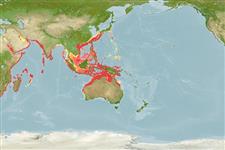Common names from other countries
Environment: milieu / climate zone / depth range / distribution range
Ecology
Marine; reef-associated; depth range 10 - 400 m (Ref. 89707). Tropical; 35°N - 32°S, 29°E - 150°E (Ref. 5222)
Indo-West Pacific: Red Sea and East Africa to southern Japan and Queensland, Australia. Also from the Paracel Islands in the South China Sea. There are no records from Madagascar, Mauritius, Maldives, Laccadives, and Sri Lanka, Indonesia, and the Philippines.
Length at first maturity / Size / Weight / Age
Maturity: Lm ?, range 99 - ? cm
Max length : 200 cm TL male/unsexed; (Ref. 2872); max. published weight: 110.0 kg (Ref. 9710)
Dorsal
spines
(total): 11;
Dorsal
soft rays
(total): 14-15;
Anal
spines: 3;
Anal
soft rays: 8. Distinguished by the following characteristics: body depth contained 2.9-3.5 times in SL; head length 2.3-2.6 times in SL; slightly convex interorbital area; straight dorsal head profile; rounded or subangular preopercle, slightly enlarged serrae at angle; almost straight upper edge of operculum; posterior and anterior nostrils subequal in size; maxilla reaches to or beyond vertical at rear edge of eye; 2-6 rows of teeth on midlateral part of lower jaw (Ref. 89707).
Mainly found in deep reef channels and seamounts, in current prone areas (Ref. 48635). Juveniles may be found in tide pools (Ref. 5222). Feeds on reef fishes, skates, crabs, and spiny lobsters (Ref. 5222). Considered to be exceedingly territorial and very aggressive towards intruders. Vulnerable to spear fishers (Ref. 5222). Hand fed by divers in certain areas, but potentially dangerous to the inexperienced. In the Hong Kong live fish markets (Ref. 27253). Solitary (Ref 90102).
Life cycle and mating behavior
Maturity | Reproduction | Spawning | Eggs | Fecundity | Larvae
Heemstra, P.C. and J.E. Randall, 1993. FAO Species Catalogue. Vol. 16. Groupers of the world (family Serranidae, subfamily Epinephelinae). An annotated and illustrated catalogue of the grouper, rockcod, hind, coral grouper and lyretail species known to date. Rome: FAO. FAO Fish. Synop. 125(16):382 p. (Ref. 5222)
IUCN Red List Status (Ref. 130435)
CITES (Ref. 128078)
Not Evaluated
Threat to humans
Harmless
Human uses
Fisheries: subsistence fisheries; gamefish: yes
More information
ReferencesAquacultureAquaculture profileStrainsGeneticsElectrophoresesHeritabilityDiseasesProcessingMass conversion
Tools
Special reports
Download XML
Internet sources
Estimates based on models
Preferred temperature (Ref.
115969): 16.8 - 27.7, mean 23.9 (based on 619 cells).
Phylogenetic diversity index (Ref.
82804): PD
50 = 0.5000 [Uniqueness, from 0.5 = low to 2.0 = high].
Bayesian length-weight: a=0.01479 (0.00762 - 0.02872), b=3.05 (2.89 - 3.21), in cm Total Length, based on LWR estimates for this species & Genus-body shape (Ref.
93245).
Trophic level (Ref.
69278): 4.2 ±0.68 se; based on food items.
Resilience (Ref.
120179): Low, minimum population doubling time 4.5 - 14 years (Preliminary K or Fecundity.).
Fishing Vulnerability (Ref.
59153): High to very high vulnerability (66 of 100).
